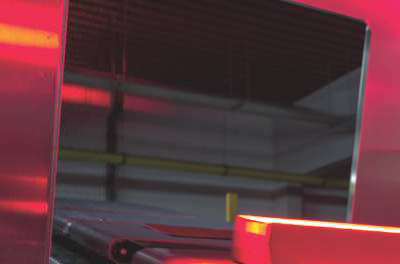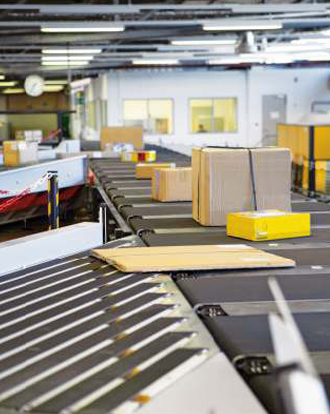Siemens Logistics and its intelligent parcel solutions
Sending parcels used to be a daunting task. One must carry the package to the post office, Sfill up necessary documents and wait for days to have it delivered to the receiver.
Before the delivery, the parcel also goes through the lengthy process of being barcode stamped with the tracking code given to the sender by the courier company.
That is the thing of the past. Today’s parcel delivery system has been revolutionized with numerous technology and intelligent solutions mainly to serve the e-commerce market which is on an ascending path.
Using intelligent solutions, the parcel being shipped goes to many easy processes on its journey to the recipient from loading to unloading, singulation and recognition all the way to sorting all in one go. For a fool-proof shopping experience it is essential to deliver the package promptly to the customer and on time.
In an email interview with Michael Reichle, CEO of Siemens Logistics, he tells Air Cargo Update about their intelligent solutions for effective and future-proof parcel logistics.
Parcel logistics
“Parcel volumes are growing – and it doesn’t look like they are going to let up any time soon. For the most part, the dynamic e-commerce market is fueling this trend, a market that is expected to almost triple in volume in the next few years,” shared Reichle.
Cross-border parcel shipping is booming like never before but it does have its quirks. Many parcels are also tagged for next-day delivery, whether on the same continent or to a destination on the other side of the world. Also, the parcels and packages common to e-commerce are typically smaller than the average. Customer expectations for the fastest delivery possible at low prices add to the challenges.
 “As the result of these trends, adjustments in processes in and around sorting centers have become necessary. Siemens’ answer is to combine its portfolio of innovative machines and software to provide tailor-made solutions for the most varied requirements. What’s more, Siemens is a proven expert in automation and digitalization, and the partner of choice for innovative and flexible solutions as well as smart software,” said Reichle.
“As the result of these trends, adjustments in processes in and around sorting centers have become necessary. Siemens’ answer is to combine its portfolio of innovative machines and software to provide tailor-made solutions for the most varied requirements. What’s more, Siemens is a proven expert in automation and digitalization, and the partner of choice for innovative and flexible solutions as well as smart software,” said Reichle.
For all steps in the parcel sorting process, from fast truck unloading to reading and coding software backed by over 40 years of technological developments. For all offerings from Siemens, flexibility is built in so that Courier, Express and Parcel (CEP) service providers can react quickly to changing volumes. Maintenance and modernization services complete the offering, because partnering with Siemens means getting the best for today and tomorrow.
“On the software side, Siemens’ recognition, controls, and IT capabilities are proven, sophisticated, and are leveraged across the chain in our offerings. This intelligent approach allows our customers to react quickly to changing volumes and allows operations to be managed holistically,” the Siemens Logistics CEO noted.
Maintenance and modernization services complete the offering. To meet the demand for digitally supported maintenance, Siemens established the Service 4.0 program. Through targeted system data gathering and evaluation, Service 4.0 is the basis for a predictive maintenance strategy.
Fully automated unloading solution
Siemens Logistics has launched a new fully automated unloading solution called RUBUS which helps improve efficiency in sorting centers.
The solution was developed in response to growing parcel numbers worldwide and the need to handle these faster. According to Siemens, thanks to RUBUS, parcel service providers can unload trailers at unprecedented speeds and therefore operations become more efficient.
“Siemens’ fully automatic solution for parcels and packages drives productivity to unprecedented levels. Parcel service providers are able to unload trailers at unprecedented speeds, namely up to 20 times faster than manual processes. This rate is controllable and can be throttled dynamically to match available system capacity,” said Reichle.
To enable compatibility with RUBUS, an inexpensive stationary belt kit is installed into the trailer or container. This covers the floor, parcels and packages are loaded normally on the belting, and the RUBUS draws itself along the belting to the end of the trailer or container in the process of unloading it.
 Michael Reichle, CEO of Siemens Logistics
Michael Reichle, CEO of Siemens Logistics
Siemens engineers drew on over two decades of in-depth application and engineering experience to come up with VarioSort EXB, Siemens’ electrical cross-belt sorter platform. This sturdy, straightforward, reliable and competitively priced solution, has already been installed in many parcel centers all over the world. It provides all essential features necessary to fulfill various sorting requirements.
“For VarioSort, we offer a number of optional features: One example is a module that records the size and weight of a parcel and uses this information to optimize parcel unloading. That means that large, heavy parcels are treated differently from small, light ones. Here, too, the advantage lies in the enhanced exploitation of the space available: Unloading is more precise and the distance between outlets can be optimized to keep the highest level of sorting accuracy,” said Reichle.
Every single step in the parcel handling chain contributes to system throughput. One core issue at parcel hubs is to quickly discharge trucks, which are arriving at higher and higher frequencies. This demand stretches manual unloading processes to their limits, so optimizing the operation is crucial.
RUBUS uses a unique method where parcels are unloaded fully automatically and at high speed with the aid of belts. The system allows a throughput of up to 25,000 items per hour. This rate is controllable, and it can be throttled dynamically at a central control station to match available system capacity. RUBUS can be configured for bulk flow as well as stream flow. In addition, it is easily adjustable to any facility without structural modifications.
Moreover, Siemens telescopic conveyors are widely used. With both belted and gravity models as well as a wide variety of options, the telescopic conveyors are a perfect solution for loading and unloading. The latest models, in particular, set new standards in regard to strength, longevity and total cost of ownership.
With both belted and gravity models as well as a wide variety of options, the telescopic conveyors are a perfect solution for heavy-duty loading and unloading. Furthermore, Siemens has in-house engineering capability to customize the conveyors as required.
Transportation and Singulation
As soon as parcels have been unloaded, they need to be transported within the sorting center quickly and effortlessly. Siemens’ conveyors can be flexibly adapted to just about any layout.
The rugged, modular, conveyor system is designed to reduce total cost of ownership by simplifying maintenance, reducing energy usage, and providing flexibility through bolt-up reconfiguration when the operation needs to change. It can be tailored in length and inclination to meet specific requirements.
“Siemens’ singulator Visicon boasts high singulation rates and a high throughput with the ability to process up to 8,250 standard parcels per hour, or 12,000 small items on a small footprint.”
Two different models of Visicon singulator are available: Visicon Polaris for larger and heavier parcels, and Visicon Capella, which is optimized for smaller and lighter parcels. But whatever the type of parcel, the job is the same: Convert a bulk stream where parcels may lie side by side into a stream of singulated parcels with a gap in between.
The Visicon’s bulk-stream control regulates parcel volume to optimize the flow from unloading all the way to the sorter. This keeps the entire parcel processing chain running at the rate of the sorter, regardless of the trends in parcel size that occur within an operation.
Enhanced technology for small items
Siemens has optimized its automatic reading technology especially for small parcels. The key success factors are the reliable detection of the receiver address block based on pretrained label types; correct address interpretation, even if the address is syntactically incorrect or elements are missing; and the accurate segmentation of single characters, especially for small fonts that tend to blend together.
 “Usually barcode reading takes place inside the camera system. Additionally, our advanced barcode algorithm can be integrated as a secondary recognition engine to boost read rates even further. Thanks to sophisticated image processing and advanced recognition algorithms, even poor-quality printed contrast barcodes can be read. Furthermore, our software can interpret 2D barcodes or customer barcodes that comprise additional parcel data,” explained Reichle.
“Usually barcode reading takes place inside the camera system. Additionally, our advanced barcode algorithm can be integrated as a secondary recognition engine to boost read rates even further. Thanks to sophisticated image processing and advanced recognition algorithms, even poor-quality printed contrast barcodes can be read. Furthermore, our software can interpret 2D barcodes or customer barcodes that comprise additional parcel data,” explained Reichle.
With bulk-processed parcels, the address label can be positioned on one of the parcels’ sides. Therefore, these are scanned from all six sides. Furthermore, their dimensions and weight are established, and addresses are resolved with recognition software. For parcels where the address labels are facing upward, a top scanner is used. This for example applies for semi-automatically inducted parcels.
Sorting
Siemens engineers drew on over two decades of in-depth application and engineering experience to come up with VarioSort EXB, Siemens’ electrical cross-belt sorter platform.
This sturdy, straightforward, reliable and competitively priced solution, has already been installed in many parcel centers all over the world. It provides all essential features necessary to fulfill various sorting requirements.
“For VarioSort, we offer a number of optional features: One example is a module that records the size and weight of a parcel and uses this information to optimize parcel unloading. That means that large, heavy parcels are treated differently from small, light ones. Here, too, the advantage lies in the enhanced exploitation of the space available: Unloading is more precise and the distance between outlets can be optimized to keep the highest level of sorting accuracy,” said Reichle.
Today’s sorting centers often have to deal with many smaller items, which is why Siemens engineers came up with VarioSort Twin. Instead of one cross belt, the VarioSort Twin has two cross belts on one carrier. This makes it ideal for transporting two smaller parcels, which results in optimum utilization of valuable space in sorting centers.
“Parcels with a maximum length of 50 cm, a width of up to 40 cm and a weight between 0.01 kg and 30 kg can be sorted on each cross belt – with a throughput of over 18,000 items per hour. The maximum speed of 2.6 meters per second can be reduced for reliably sorting lighter items.”
With convincing sorting performance figures of over 13,000 parcels per hour, the VarioSort Single is virtually maintenance free, and its energy-efficient motors make for low life-cycle costs.
It is designed to handle parcels measuring between 10 cm and 125 cm in length, between 10 cm and 60 cm in width, and weights between 0.1 kg and 60 kg. Additional benefits include short installation times as well as globally available after-sales parts and services.
Networks, hubs and the last mile delivery
Growing volumes require new distribution centers and flexibility in volume distribution. These developments have an impact on and challenge existing network structures. With the Network Booster, Siemens provides full network transparency, forecasting and optimization.
For example, the Supply Chain Suite (SCS) optimizes network structures on a strategic or tactical level with benefits for both transport structures and operational hub loads.
Moreover, the Hub Booster software employs advanced analytics to effectively improve performance. Real-time visibility along the hub process assists in pushing a hub to optimal performance. Automatically generated forecasts guide operators and ensure the timeliest intervention possible.
Siemens Planning, Prediction & Control (PPC) closes the gap between the process chain within a hub and the surrounding processes. It plans, controls and monitors operative processes at the hub, from the arrival of transporters through to unloading, sorting, loading and departure.
Furthermore, over 40 percent of operational costs are typically allocated to last mile distribution. In this area, Siemens software products provide real-time transparency and address two basic tasks to improve operational efficiency: The first is to determine the optimal location for delivery depots and to define delivery zones. The second is dynamic workload balancing – which is adjusted daily in real time – and tailoring delivery zones.










